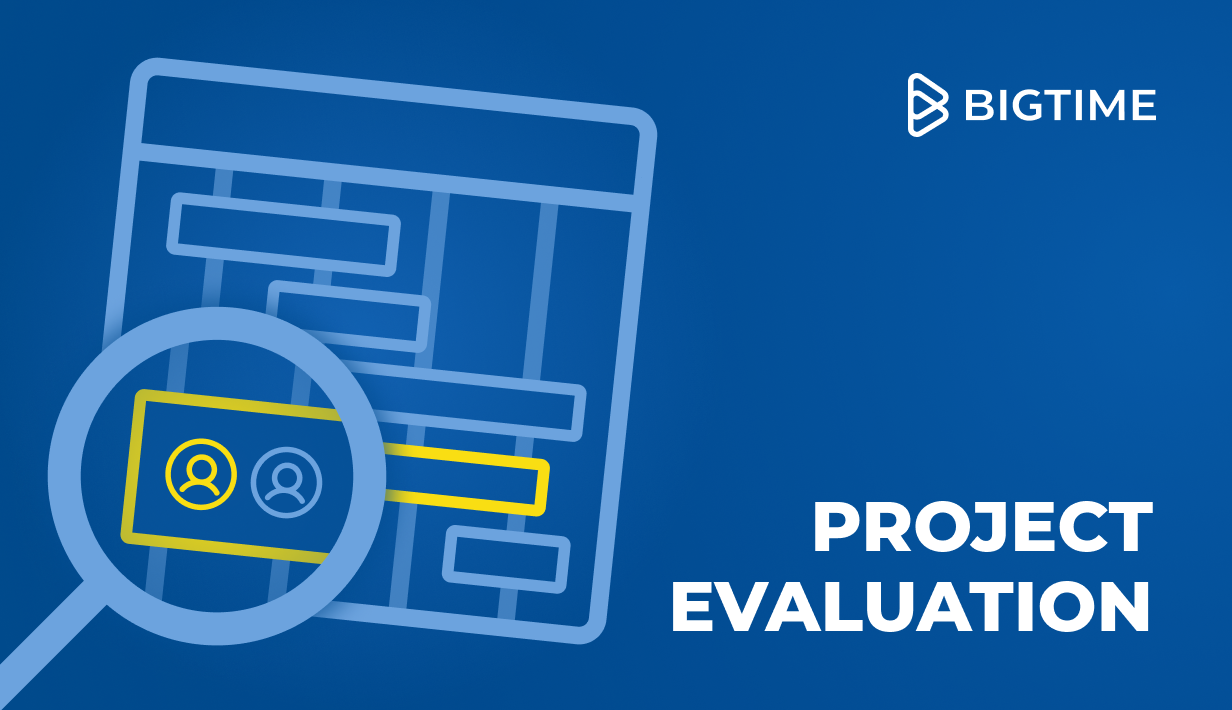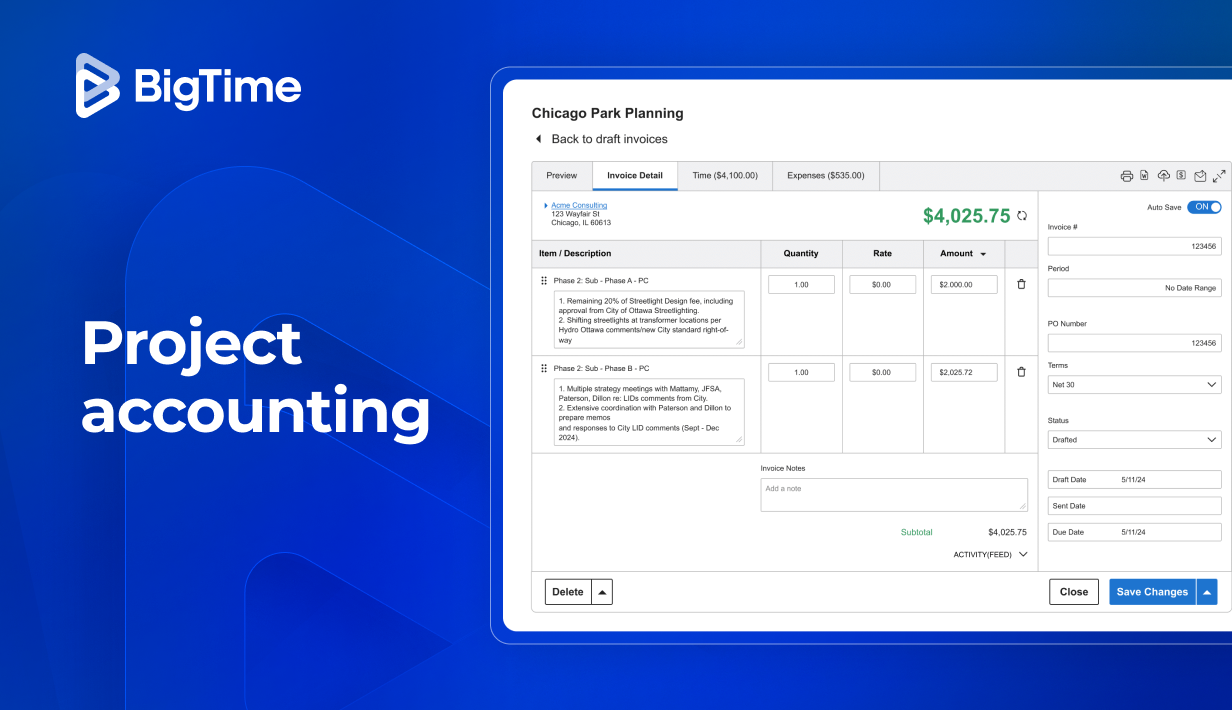Last update: July 8, 2025
Monitoring key metrics is essential to the project success, no matter the industry. Yet, when managing a broad portfolio, even the most experienced project managers can find it challenging to keep track of everything. This is where a structured project evaluation process becomes invaluable—helping streamline oversight and unlocking a range of tangible benefits.
In this article, you will learn:
- What is project evaluation?
- Why is project evaluation so important?
- What are the best project evaluation methods?
- How to evaluate a project step by step?
- What are the benefits of project evaluation?
What Is Project Evaluation? Definition
Project evaluation is the systematic assessment of a project’s planning, implementation, and outcomes to determine its effectiveness, efficiency, and relevance to the initial project goals. It involves collecting and analyzing data against predefined criteria and metrics to understand how well a project met its objectives, what worked or didn’t, and what lessons can inform future initiatives.
Why Is Project Evaluation So Important?
Even the best project plan rarely reflects the project execution. With endless changes to project scope, the final project outcome might surprise you – and not in a pleasant way. Project evaluation prevents such unpleasant surprises.
Since the very beginning of the project, conducting evaluations supports strategic alignment between team members and stakeholders. By ensuring that everyone contributes to the project objectives, project managers can support delivery throughout the project lifecycle instead of facing the consequences after its (often delayed) completion.
Project evaluation also contributes to stakeholder satisfaction rates. With clear plans and transparent communication, it is easier to fulfill their expectations even in unforeseen circumstances. Drawing conclusions from meticulously tracked processes is much easier, too, improving the success rates in your future projects.
Project Evaluation Criteria
When evaluating a project, teams typically rely on clear, measurable criteria to determine success and alignment with business goals. Common criteria include:
- Cost-effectiveness – whether the project stays within budget while delivering value,
- Schedule performance – meeting deadlines and milestones,
- Quality of deliverables – ensuring outputs meet defined standards and client expectations.
- Resource utilization – evaluating how efficiently people, tools, and time were used.
- Strategic alignment – ensuring the project supports organizational objectives
These measures help project managers avoid scope creep and maintain stakeholder trust.
Beyond these fundamentals, stakeholder satisfaction often serves as a critical barometer of success, capturing whether clients or internal teams feel their needs were met.
By establishing these criteria upfront, teams can better monitor progress, make informed adjustments, and deliver results that matter—turning good intentions into measurable achievements that drive the business forward.
Best Project Evaluation Methods
Project evaluation is more than just gathering random project metrics. It is a process that oversees the project before, during and after its execution and aims to improve it, regardless of its type. The evaluation methods represent a more systematic approach to such analysis in the project lifecycle. Here are the most popular qualitative and quantitative methods for evaluating a project based on relevant data.

Pre-Project Evaluation
Pre-project evaluation is a strategic analysis conducted for upcoming projects before they begin. Its purpose is to define the project’s core objectives and confirm that it can be successfully executed within the identified constraints.
Due to its comprehensive nature, pre-project evaluation encompasses all factors that might impact the project success, from need assessment and cost benefit analysis, to resource feasibility and risk analysis. As a result, when done correctly, this project evaluation method allows project managers to mitigate risks and support transparent, data-driven project management.
Post-Project Evaluation
Is your project already over? Post-project evaluation can help you draw as many conclusions from it as possible. This structured project review aims to analyze how well the project met its objectives, stayed within scope, time, and budget, and delivered value to stakeholders – and, of course, can identify what went wrong.
Post-project evaluation takes into account a broad range of factors. It analyzes not only the project performance, but also the use of project budget and project resources. It also considers an overall quality of the project and, as a result, it is an important tool for improving future customer satisfaction rates in your business.
Process Evaluation
Want to go a little deeper in your analysis? Let’s take a look at the individual processes impacting your project performance – and process evaluation can help you with that. This project evaluation method focuses not on goals and objectives, but on the processes that lead to the final results. Its purpose is to understand how the work was done, how well it adhered to the plan, and what factors influenced implementation.
While process evaluation focuses on just a fraction of the project, it answers questions critical for its delivery. Was everything executed as intended? Were there any deviations from the plan? Why did they happen? If you’re looking to answer these questions, this method is a tool for you.
Ongoing Project Evaluation
Some projects require constant vigilance from their project manager. If you have one of those in your project portfolio management, an ongoing project evaluation can make your job much easier.
Ongoing evaluation is a real-time, iterative process of collecting data, measuring performance, and analyzing results as the project unfolds, rather than waiting until the end. It allows managers to monitor whether the project is progressing as planned by providing them with the information on key KPIs, such as profitability, work costs, tracked time, and more. In short, if you want to get a bigger picture of the project that’s already under way, this ongoing evaluation is the best choice for you.
Goal-Based Evaluation
When deliverables take the lead, goal-based evaluation is definitely the right method for evaluating the project. It is a structured evaluation approach that focuses on assessing the degree to which stated goals or objectives – set at the beginning of the project – have been met.
This technique is strongly based on comparing actual project progress against the initial plans. As a result, it is a perfect method for identifying gaps and delays that might affect the final outcomes.
Formative Evaluation
If your projects have a tendency to go sideways during the early stages of development, formative evaluation will help you find the root cause of such shifts. The main goal of this project evaluation technique is to provide ongoing feedback that helps improve the design, delivery, and effectiveness of the initiative while it is still in progress. So, if you aim to guarantee the success of your project from the start, this is the perfect solution for you.
Summative Evaluation
In contrast to formative methods, summative evaluation method is an assessment conducted at the end of a project or program to determine its overall effectiveness, outcomes, and impact.
Similarly to goal-based evaluation, this technique compares actual outcomes to intended objectives and provides insights into what worked, what didn’t, and why. However, summative evaluation focuses on the overall goal of the project, while goal-oriented methods tend to analyze the progress of individual tasks and milestones. Therefore, summative methods are better studied for final assessment of the project instead of assessing the quality of individual deliverables.
Outcome Evaluation
If your project aims to make an impact, outcome evaluation will help you ensure that the final product or service meets all the expectations.
Outcome evaluation is the process of assessing the specific changes or benefits that occurred because of a project. From all the evaluation methods, this one is the most flexible and, at the same time, the most imprecise, as the impact of a project often cannot be measured with numbers. However, if your goals are measured in relation to the original goals and objectives—especially those related to knowledge, behavior, performance, or conditions, this might be a perfect match for you.
Project Evaluation Steps Explained
Regardless of the evaluation methods you decide to use, the project evaluation framework always looks similar. It includes:
Planning The Project Evaluation Process
To develop strategies for evaluating the project’s performance, you need to start with identifying the factors impacting the project’s effectiveness. Those might vary from project to project, but, in general, they include:
Project stakeholders and their goals
There are dozens of people involved in the project planning process. Therefore, knowing who really has the last say on the project timeline is essential for identifying any success metrics. Discuss the ideas for future projects with key stakeholders on the customer’s side and your project team to confirm your priorities are aligned, and your project can be delivered in a timely manner.
Project evaluation criteria
Does your project have any key parameters that reflect its success? If it does, you probably can turn them into your basic evaluation criteria. While the exact criteria may vary by industry or project type, the following are the basic, widely accepted evaluation criteria used across most project management frameworks:
- Relevance, assessing how well the project’s objectives matched the organizational mission or client needs.
- Financial performance, which monitors various financial and cost effectiveness key performance indicators, such as the use of project budget, overall profitability, or profit margins.
- Effectiveness, or the degree to which planned outcomes and deliverables were realized.
- Project execution, which compares planned vs actual project progress.
Project Data Collection and Implementation
Project planning is just the beginning of the project evaluation process. Once the project starts, the project manager must pay extra attention to the project status and all its metrics impacting the final project outcome.
While completing the project evaluation throughout its duration, you should keep a particularly close eye on metrics such as:
- The completion percentage that can indicate any delays in your project.
- Scope creep that monitors unauthorized changes or additions to the project scope.
- The use of project budget. With too much expenses that were unaccounted for at the planning stage, money can quickly run out.
- Employee utilization rates. Overutilized employees experiencing schedule conflicts might be less efficient, resulting in a suboptimal quality of their work and dripping team performance.
Of course, numerical metrics are only a part of the project’s success. Intended outcomes also depend on the quality of the deliverables, which also needs to be monitored throughout the project. By measuring error rates or rework frequency, you can identify any issues at an early stage and prevent them from delaying your project.
Conclusions and Recommendations
The work doesn’t end while the project does. After completing the project, project managers must collect data on its performance, create reports and start to draw conclusions. The goal? To evaluate the completion of project objectives, identify any bottlenecks, and make future projects better than ever.
Process Alteration
Drawing conclusions in project management is only the first step—implementing them based on your evaluation findings is where real impact happens.
Use insights from the project evaluation to refine individual processes, improve specific types of projects, or introduce new procedures that streamline operations and reduce errors. However, keep in mind that not every recommendation will apply universally. What works well for one project may not be suitable for another, so adapt your approach to fit the context and needs of each initiative.
Benefits of Project Evaluation
But why bother to even start the project evaluation process? The short answer is: to track project’s performance, mitigate risks and improve future projects even more. Still, evaluating a project has even more benefits, including:
- Informed decision making. Real-time adjustments and changes to the plans are easy when you know exactly what the current project status is. Project evaluation provides you with that information.
- Continuous improvement. Mistakes do happen, but you can make fewer of them if you know what worked (and what didn’t) in previous projects or processes. Assess project success regularly to make necessary improvements regularly.
- Performance tracking. Get rid of unpleasant surprises at the end of the project. By tracking its performance from start to finish, you can easily identify any issues, preventing delays and cash flow issues.
- Strategic alignment. Project evaluations help all the key stakeholders be on the same page, minimizing conflicts and streamlining key processes.
- Risk reduction. Through ongoing or post-evaluation, risks are identified and mitigated earlier in the project lifecycle, improving the chances for the project success.
Too Time Consuming? Make Project Evaluation Faster with BigTime
When done in simple documents or Excel spreadsheets, project evaluation might be a time-consuming and burdensome task. Fortunately, a comprehensive evaluation can be easier with the right project management practices – and the right project management tools – such as BigTime.
An example of a project budget overview in BigTime
In BigTime, you can:
- Conduct effective evaluations and discover areas for improvement in seconds with comprehensive overview of projecs, resources, and finances.
- Perfect your project planning with error-free resource allocation – we will notify you about any cases of overutilization!
- Monitor project progress in the real time. Each time your project team members track time, their efforts will be tracked in project statistics.
- Keep track of the project budget. Overheads, work costs, and more – we have valuable insights on them all!
- Create progress reports in seconds. Don’t know what you’re looking for? Our AI features will help you and make outcome measurement a breeze.
And these are not just empty promises – you can see how BigTime can help you monitor project’s performance in the interactive demo below.
And that’s just a fraction of BigTime’s capabilities. Book a demo to see what else we can do to boost your projects’ performance.




